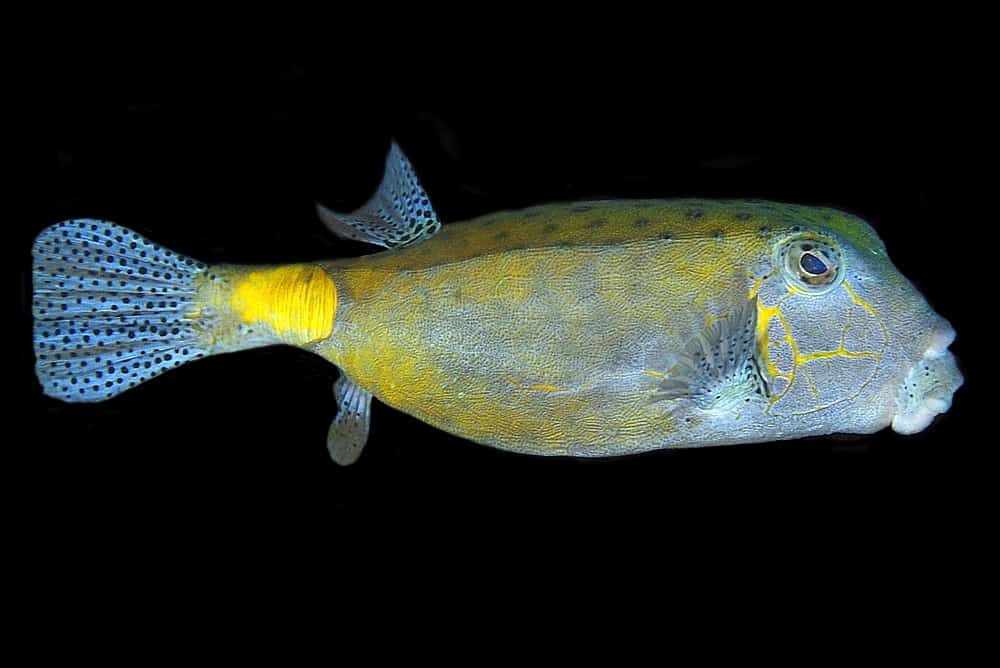The yellow boxfish (Ostracion cubicum) belongs to the boxfish family. The Ostraciidae family contains 23 different fish species. It can be found in the Pacific and Indian Oceans, as well as the southeastern Atlantic Ocean, on reefs. A yellow boxfish’s scientific name is Ostracion cubicus. Ostracion is a Latin word that refers to the carapace or shell structure of this fish. Cubicus translates to “cube-like.”
Although it is extremely unusual, when a boxfish is stressed, it can release a lethal poison known as “ostracitoxin,” which can cause it to kill itself and everyone else in the waterway. If it dies, this can also happen. When anything is about to die, it becomes slower and the colors fade more quickly. You can detect whether there is poison in the water by seeing foam on the surface and other fish that are dormant. The brilliant yellow tint and black patches are a type of aposematism (warning coloration) to any possible predators.

Table of Contents
Distribution and Ecology of Yellow boxfish
The Pacific, Indian, and southeastern Atlantic Oceans are home to these saltwater fish. They can be found off Australia’s western and eastern beaches. Yellow Boxfish can also be found off the coast of the United States. They live in lagoons and have a coral reef habitat. These fish can be found in depths ranging from three to 920 feet. They are saltwater fish that require water temperatures of 72 to 78 degrees F. They also require a pH level of 8.1 to 8.4 in the water. They are popular because of their horned, colorful, or otherwise distinctive appearance.
Different Types of Yellow Boxfish Species
Smooth trunkfish: The shape and texture of this fish’s body earned it the name. It’s dark brown with white flecks. They can be found in the Atlantic Ocean off the coasts of Mexico, Florida, and South America’s eastern coast.

Round belly cowfish: It gets its name from the two little horned structures that protrude from its head. They can be found on coral reefs in the southeastern Atlantic Ocean and in the Pacific Ocean off the coast of California.
Spotted boxfish: These fish live off the coast of Mexico in the Pacific Ocean. The white-spotted boxfish is another name for them. Their elaborate, vivid blue bottom body with golden spots explains this.
Body Characteristics
As a boxfish gets older, its look changes. It’s box-shaped, as the name implies. Boxfish are also noted for their armored and inflexible bodies, which impede mobility in most circumstances. The boxfish’s carapace shape, which is far more advantageous for its modified way of swimming, known as ostraciiform locomotion, compensates for this disadvantage. It is a bright yellow color when young.
The coloring fades with age, and very old examples have a blue-grey to black coloration with faded yellow. Yellow boxfish can grow up to 45 centimeters in length (18 in). The shell structure beneath their scales gives them a boxy form. Because of their unusual form, they are slow swimmers. Some even characterize their motion as floating.
Diets
The diet of the yellow boxfish consists primarily of marine algae, but it may also consume worms, sponges, crabs, mollusks, and small fish. A boxfish will occasionally blow water into the sand in search of flora and food. They hunt for tiny prey across rocky slopes and at the sandy bottom of a lagoon.
Breeding

The yellow boxfish is a solitary creature. Breeding takes place in tiny groups of 1 male and 2–4 females in the spring. Females lay eggs towards the surface of the water. The male boxfish releases sperm to fertilize the eggs. A female boxfish can lay eggs every day for a month. The length of the pregnancy is unknown. On average, boxfish live for four years.
RECOMMENDED ARTICLES
- Bowfin Fish Species- Characteristics, Habitats And Spawning
- Standard Catfish Business Plan For Beginners And 2 Detailed Challenges
- How to Start a Fish Farming In Nigeria – 6 Basic Challenges of And How To Manage It
- Standard Snail Farming Business Plan And How To Manage It
- Standard Pig Farming Business Plan And Finance
If you like, please share it. sharing is usually caring.




